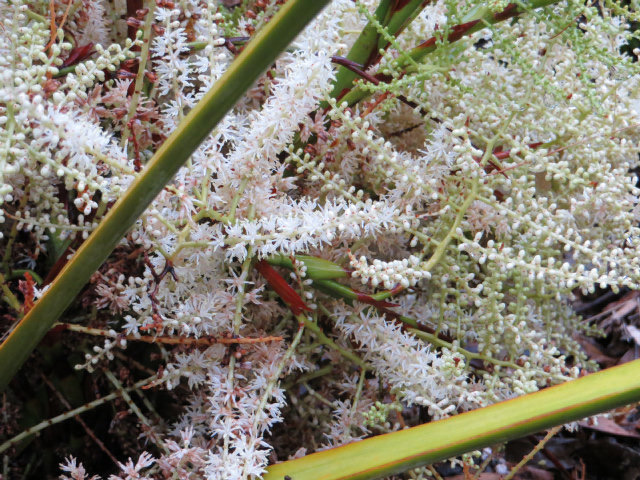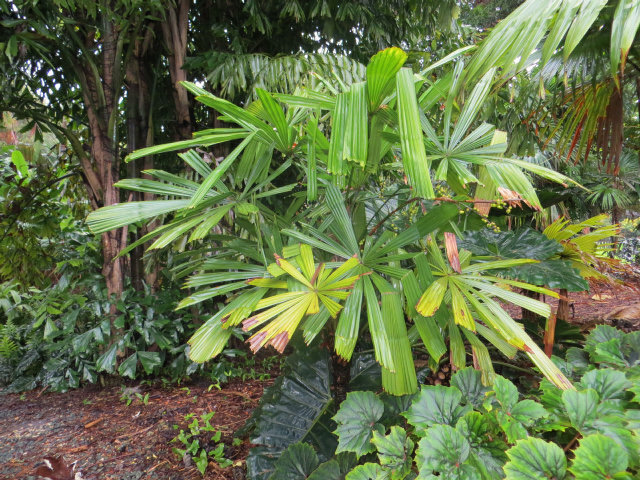Biggest Palm Myths Debunked

As Published in the Miami Herald
Palm trees are one of the most beloved landscape ornamentals in South Florida and are a relatively simple plant to grow in your yard. Despite the popularity and ease of growing palms, most homeowners know only scant truths about the palms residing in their backyards. Palm myths have run rampant and are becoming more widely accepted than the facts. For an ornamental that is so dear to our hearts and vital to our landscape, it is a shame that they are misunderstood. The time to debunk these myths is long overdue.
• Myth #1: Palms are trees. The name does lend many to believe that palms are actually trees. In fact, the differences between palms and trees far outweigh their similarities.
 |
| Palm branching is extremely rare, only exhibits in two palm genera, like this mazari palm (Nannorrhops ritchiana), and is quite different from branching observed in trees. |
A tree is a type of perennial woody plant that exhibits secondary branching from a single main trunk and has multiple growing points. Palms have an entirely different form, more closely related to grasses. Palms have only one point of new growth, the bud or palm heart, and grow from that one point. With the palm producing one new leaf at a time from the bud, the newest leaf, or spear, is easily identifiable. As a new spear is formed, the current spear will fold open and join the canopy. As the leaves age they move throughout the canopy, turn brown, die and eventually drop off. Palm trunks are not woody and cannot heal, grow, shrink or change in any way once formed.
• Myth #2: Palms are wind pollinated. While it is possible for palms to be wind pollinated, new studies prove that most palms are not. Palms are angiosperms, meaning they produce flowers with pollen and nectar. Nectar is a food source for many insect pollinators. Although the nectar reward is minimal, many insects visit palm flowers and aid in pollination. Major palm pollinators include bees, beetles, flies and wasps. Most of our native palms, such as Sabal minor, or bush palmetto, attract a variety of insects to their delicate flowers, and pollination is not insect species-specific. In one rare case, a Fiji palm, Pritchardia thurstonii, is pollinated by native hummingbirds.
 |
| Attracting many insects, the inflorescences (stalks of flowers) of the Sabal minor or bush palmetto overwhelm the dwarf plant when blooming. |
The myth of wind pollination began when researchers first started studying palms in Europe. The one palm that grew in Europe near these researchers, the European fan palm, Chamaerops humilis, is wind pollinated. Researchers assumed that the European fan palm was the rule, not the exception. For decades, people have given credit to wind and disregarded insect pollinators.
• Myth 3: Palms love the beach. When asked to think about happy palms, our minds quickly conjure images of palms lining white sand beaches. Our idealized palms revel in the beach vacation. South Florida native palm trees, along with a few other palm species, including the archetypal coconut palm, can withstand these conditions, but these individuals are in the minority.
 |
| In need of shade, rich soils and constant humidity, this Licuala lauterbachii fairs well in a much protected area of the garden. |
South Florida is known for its sandy, limestone soils, distinct wet and dry seasons and blazing sun. About fifty palms are suited for these conditions. The remainder of the 2,500 palm species prefer rich, acidic soils protected by the shade, in regions that are warm and wet year-round. These areas are extremely dissimilar to the beaches of South Florida and the Caribbean. Much like the early researchers in Europe, we have fabricated a rule out of our own personal palm experience.
Palms are much-loved landscape ornamentals used in most South Florida yards. Yet, these stunning plants are shrouded in myths that detract from their true beauty. By learning the truths about our favorite landscape pieces, we increase our understanding of palms and begin to take better care of them. Next time you hear any of these palm myths, start spreading the truth and help increase awareness of the benefits of these magnificent plants.
